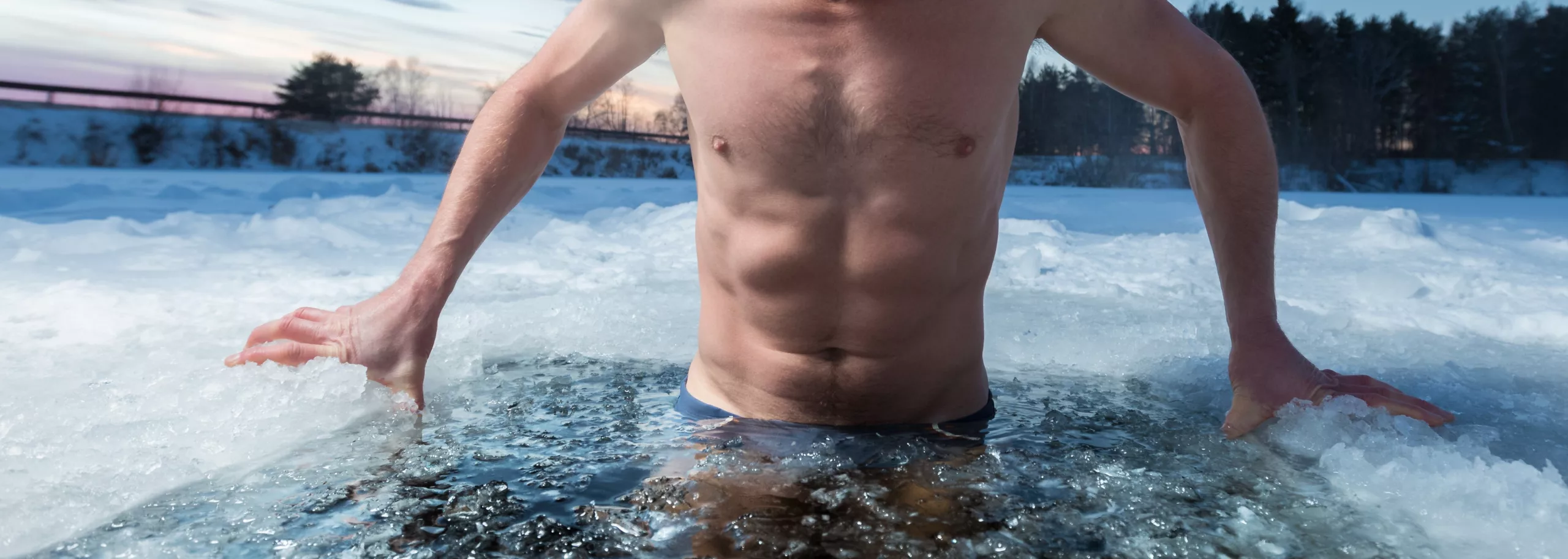Contents of Research Review
- Background & Objective
- What They Did
- What They Found
- Practical Takeaways
- Reviewer’s Comments
- About the Reviewer
- Comments

Background & Objective
The goal of this study was to compare the effects of cold water immersion (CWI) in football linemen (i.e. small body surface area (BSA) to body mass (BM) ratio [BSA:BM]) and cross-country athletes (i.e. large body surface area to mass ratio [BSA:BM]) performed after a heating protocol.
What They Did
The athletes were exposed to a heating protocol that consisted of 10 minutes of sitting in a heating chamber at a temperature of ~ 39 ºC and relative humidity of ~ 40 ºC followed by 20 minutes of exercise until the core temperature (Tc) reach 39.5 ºC or volitional exhaustion was achieved. After that, athletes were immersed in cold water tubs at a temperature of 10 ºC until the Tc achieved 37.5 ºC. Core temperature was measured every minute during the cold water immersion (CWI) and was obtained from a temperature sensor that was ingested by the athletes. The analysis was performed once the athletes’ had reached a Tc of 37.5 ºC, which in this case, was after 7 minutes. Therefore, the first athlete was removed from the CWI tub after 7 minutes (e.g. achieved Tc of 37.5 ºC after 7 minutes).

What They Found
Differences between the groups were found for the cooling time to achieve the Tc of 37.5 ºC (target Tc / time) and slope of lines of the Tc / time. The football linemen (FB) required significantly more time to reduce Tc to 37.5 ºC (~ 11 minutes) than the cross-country (CC) athletes (~ 8 minutes). As expected, the Tc / time was significantly lower in the FB (~ 0.156 ºC per minute) in comparison to CC (~ 0.255 ºC per minute). Strong correlations were found between the rate of cooling and body mass, total BSA, BSA/mass, lean body mass/mass and % of body fat.
Practical Takeaways
The main takeaway message from this study is that body composition affects the decrease in Tc when athletes are exposed to CWI. In particular higher measures of body mass, total BSA, BSA/ mass, lean body mass/ mass and % of body fat are associated with a decrease in the rate of cooling of Tc.
Another important finding from this study is that cooling rates vary considerably between subjects, reinforcing the need to monitor individual rectal temperature during CWI. Lastly, a CWI protocol of 11 minutes at a temperature of 10ºC seems to be ideal for large athletes such as football linemen or other athletes such as rugby first rows.
Reviewer’s Comments
The findings from this study demonstrate that decreases in Tc from CWI are highly correlated with different measures of body composition. Subjects with lower BSA:BM should be exposed to more severe cold protocols in comparison to smaller BSA:BM when reductions in the Tc are desirable.
While it can be difficult to have cold baths with different temperatures within the same environment, by increasing the duration of the protocol one can increase the intensity of the modality when individualisation is desirable. Given that strong correlations were observed between the rate of cooling and % of body fat, coaching staff can use % of body fat as a reference to individualise CWI interventions.
Although I have never used the BSA:BM to individualise CWI interventions, I have provided some individualisation based on two factors: 1) perceived effectiveness and belief in CWI as a recovery modality; and 2) the percentage of fat mass. In order to respond to these two factors, I use cold tubs at different intensities, categorising them as severe (~ 10 ºC) or less severe (~ 15 ºC) and using different immersion times (e.g. 8 or 10 minutes). With this, I can have a combination of 4 different intensities:
Low: 8 minutes at 15 ºC;
Moderate – Low: 10 minutes at 15 ºC;
Moderate – High: 8 minutes at 10 ºC
High: 10 minutes at 10 ºC
Want to learn more?
Then check these out…
Read ‘Cold-Water Immersion for Athletic Recovery: One Size Does Not Fit All‘.
Read ‘Influence of body composition on physiological responses to post-exercise hydrotherapy‘.
The full study can be read here.


